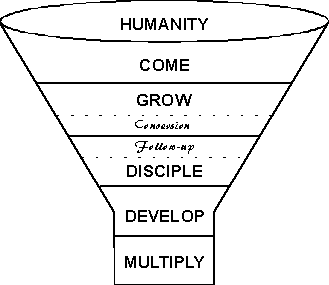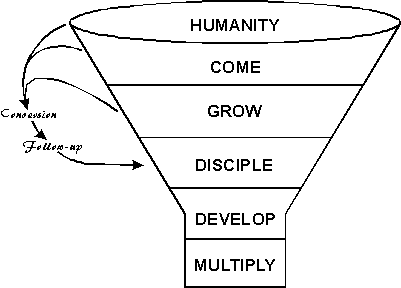
As I reflected on the commitment level model of youth ministry, began to implement it in a local church context, and taught it to youth pastors, I developed six levels of ministry aimed at different commitment levels.
1. Contact
We make contact and establish a relationship with unchurched youth on their turf through a Contact Event. These youth are either evangelised and discipled in their own environment or invited to the next level of ministry.
2. Rave
Unchurched youth are invited to a Rave Event which is a four-week programming strategy designed to introduce them to the group, discover truth about Christ and hear the gospel in a non-threatening environment.
3. Follow-up
The new convert attends a Follow-up Event where they are established in the faith.
4. Growth
The young Christian attends a Growth Event designed to help them grow spiritually - either a group Bible study or a cell group.
5. Impact
The Christian youth is invited to take part in an Impact Event where they can reach out and impact their community for Christ through service projects or missions.
6. Leader
Mature Christian youth who are ready for leadership involvement are trained at a Leader Event.
When we compare these levels to the original model, which uses the Humanity, Come, Grow, Disciple, Develop and Multiply commitment levels, we note the following:
A. The Revised Model Includes the Original Levels
The various levels of the two models overlap as follows: Humanity (Contact Events take place away from the youth group's meeting place - on the turf of unchurched youth); Come (Rave Events include youth who are at the Come and the Grow commitment levels); Grow (Rave Events target youth at this level and they go through Follow up if they are converted); Disciple (Growth Events nurture youth who take the initiative for their spiritual development); Develop (Impact Events provide service opportunity for youth who take initiative for developing other youth); and Multiply (Leader Events train young people for leadership and mobilise them to lead ministries within the group).
B. The Revised Model Adds Two Significant Levels
I believe two levels have been identified that are critical to the practical functioning of the model, ie. Conversion and Follow-up. In terms of running youth ministry it is important for one ministry to be aimed at evangelising youth (not to limit conversions to one event, but to ensure a regular presentation of the gospel to youth), and another to be aimed at following up youth who respond. If these levels are not identified youth groups often fail to get around to following up new converts. One of my students, Graeme Codrington, drew a diagram which integrated these two stages into the original model. He placed Conversion at the bottom of the Grow Level section in the funnel; and Follow-up at the top of the Disciple Level section.

A further weakness of the original model is that the Come and Grow Levels are not necessarily stages that all youth pass through on their way to the spiritual maturity. Also, a person may be converted in the Humanity Level and never progress through the Come and Grow Levels. Yet both Conversion and Follow-up are essential to the process. Is there possibly a better way to integrate these two steps into the model? The diagram below shows an arrow arching from the Humanity, Come and Grow Levels into the Disciple Level with two stages along the way: Conversion and Follow-up. See diagram:

I am not suggesting that those who designed the original model did not place great importance on salvation and follow-up, but as I have trained youth pastors and consulted in local churches, I have realised that they need to develop a model of ministry that clearly identifies these levels in order to be effective.
The following tables summarise the commitment levels as presented in various models:
| Original | Revised | Saddleback | Commitment |
| Humanity | Pre-Christian | Community | Uncommitted |
| Come/Grow | Visitor/Seeker | Crowd | To Attend |
| Come/Grow | New Convert | Congregation | To Membership |
| Disciple | Believer | Committed | To Maturity |
| Develop | Worker | Core | To Ministry |
| Multiply | Leader | Core | To Missions |
Return to Model of Youth Ministry